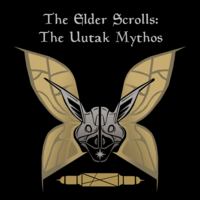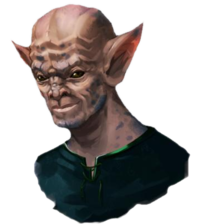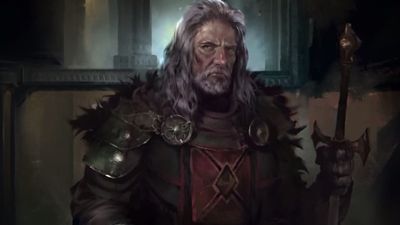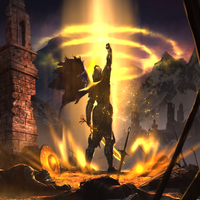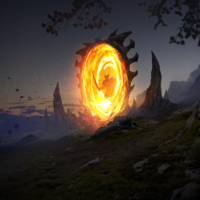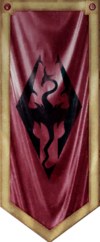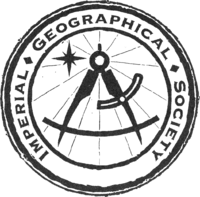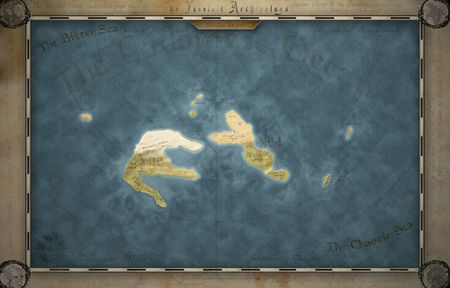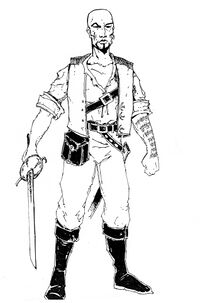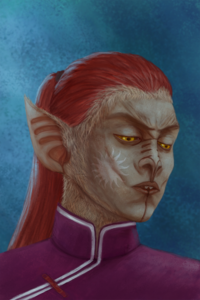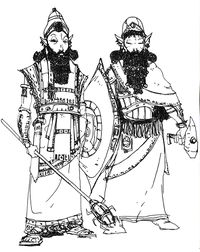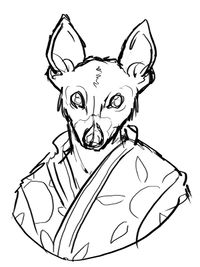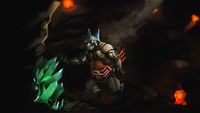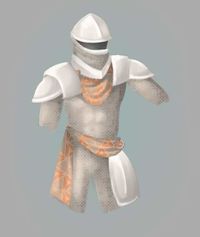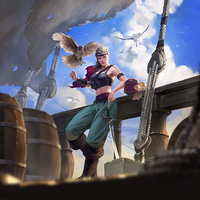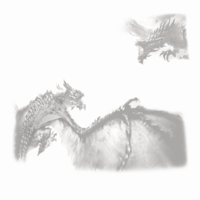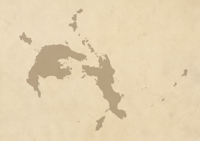General:Uutak Mythos/The Emperor's Guide to Yneslea, 2nd Edition
- "My pen shall be my voice today, for my throat has turned raw from years of sorrow and belittlement. Raise these flags and pieces of parchment high above the walls of Oexra'numsaz, my comrades-in-arms! I wish to attempt some conversation with the Dull Council before I lay siege to them." — Hannar Almost-King
Dawn Sings Towards the Starry Sea: The Emperor's Guide to Yneslea, 2nd Edition is the Uutak Mythos equivalent and tribute to the pocket guides released with past Elder Scrolls games like The Elder Scrolls Adventures: Redguard, The Elder Scrolls IV: Oblivion, and The Elder Scrolls Online. The Emperor's Guide to Yneslea, which was written a few years before the events of The Elder Scrolls V: Skyrim in-universe, began production on September 25th, 2019 real-world wise and is still currently a work in progress. Upon its completion, digital (and perhaps paperbound) copies of the guide will be supplied to those interested in having them.
This page serves as a transcription of the EGY, and its formatting and capitalization shall follow the documentation procedure made for the canon guides by UESP. Underlined text represent footnotes and margin scribbles that appeared in the original guide. These are written by a low-ranking member of the Third Aldmeri Dominion's Thalmor. These footnotes can be viewed either by hovering the cursor over the underlined text, or by clicking the [nb] link at the end of the line. Italicized text in certain boxed sections in are also the notes of the Anonymous Thalmor reader.
Contents
- 1 Acknowledgements
- 2 Intellectual Properties
- 3 An-Out-Of-Game-Statement
- 4 I.I: Dedication
- 5 II.I: The Nine Prayers and the Seventeen Curses
- 6 III.I: Preamble
- 7 IV.I: Memories of the Ice Cream Lanes — The Yneslean Archipelago
- 8 V.I: Descendants of the Dwemer — The Echmer
- 9 VI.I A Dragon'd Sea — Yneslea After the Dawn
- 10 See Also
Acknowledgements[edit]
As always, I would like to take the time to give special thanks to the following individuals and communities, for always inspiring me to achieve greatness even in the darkest of times:
Michael Kirkbride, Lawrence Schick, Leamon Tuttle, Gina Bruno, Jessica Folsom, Cartogriffi, Darya Makarava, Chris Franzen, Chris Nelson, Michael Zeigler, Claudine Berube, Audrey Hampton, Amy Gold, Cody Glen Hagy, Felix Macias, Phil Hinds, Tabytha Counts, Josh James, Todd Damrath, Noah Searles, Trevor Andersen, Evan Smith, Andrew Cook, David Yombalakian, Gabe Bretthauer Andrew Watson, Edmund Rees-Thomas, Jimmy Danger Burley, Gabriel Mesquita de Almeida, Aidan Martin, Cristina Carry, Charles Brandt, Alexander Payne, Tim Chalupka, Dillon Kite, Christiana Roth, Jasser Chahine Letaief, Jonathan Ondreka, Jeremy Hoffman, Jona Alb, Gianni Mmojica, Vienna Nicole, Melissa Tackman, Martynas Bielinis, Ross Bailey, Ryan Rinehart-Taylor, Addison Sanford, Silviu Glaman, Marina Smirnova, Nathan John Rockel, Zach Reiter, Arianne Tan, Jessie Roy, Jesse Mellor, Stygies VII, Dylan Robinson, Atvelonis, the /r/teslore subreddit, the Unofficial Elder Scrolls Pages, Tamriel Foundry, the Imperial Library, the Elder Scrolls Wiki, the Unofficial Elder Scrolls RPG Discord server, the Uutak Mythos Discord server and of course, the developers and former developers of the Elder Scrolls franchise.
Thanks for making this universe so fun, and inviting me into it in the first place, and to those I may have forgotten to mention by name, I want you to know that you will always have a place to sit at by my fire, so remember who you are.
Intellectual Properties[edit]
The author of this book does not claim ownership of any of the intellectual properties found within aside from the Uutak Mythos itself. This is a purely unofficial, nonprofit, fan-made work, and its commercial distribution to anyone under any circumstances is strictly prohibited. The Elder Scrolls franchise is a Copyright © (1993–2019) of Bethesda Softworks LLC, a ZeniMax Media company. The Elder Scrolls, Bethesda Softworks, ZeniMax and their respective logos are registered trademarks of ZeniMax Media Inc. All Rights Reserved.
The author of this book also does not claim ownership of any of the images that appear in this or any connected works, outside of the ones commissioned solely for this book or having already belonged to the Uutak Mythos beforehand. All artwork officially owned by Bethesda Softworks LLC goes uncredited outside of this sentence; artwork from other content creators will be credited.
An-Out-Of-Game-Statement[edit]
Insert cute and heartwarming speech from IFW about the Uutak Mythos, sunshine, candy, rainbows, and unicorns here because we all love that kind of smooth jazz.
But in all seriousness, I suppose it is that time again. Normally, I'd do a long speech in regards to the really in-depth things that I have written (like with my other lore-essays and guides of the past), but you know what? I'm not going to make this one super in-depth or long. I want it to be short, sweet, and to the point. Kind of like Echmeri ice cream, but with double the charm and less the money (because it's on the house). Back in 2014, I was 16 years old when the first few things relating to Uutak were written. Now, it's 2019 and I'm 22. A lot of things have changed, interestingly enough, but that's just how life goes. You meet new people, you lose old people; you experience joy, you suffer from heartache. At the end of the day, everything is supposed to change—is meant to change.
But if there's one thing that hasn't really changed, it's my love for the Elder Scrolls and my love for writing. It both surprises me and makes me happy that even after all these changes in my life, Uutak is still going strong and the Elder Scrolls keeps delivering more things that I love. Even if the Mythos isn't your cup of tea, I'm just glad I was able to share this with the community at large. And if it is your cup of tea, well, thanks for keeping me going. Stuff like this isn't possible without people like you. So... thank you, very much. Continue to do great things, people. And remember to drink your ovaltine.
Sincerely,
LaJaveyon Saunders (IceFireWarden, Al-Hatoor)
I.I: Dedication[edit]
- Being a concise descriptor in both art and prose of this Foreign Land,
- With its largely enigmatic and undocumented nature,
- And the noteworthy features of its people, customs, history, and other pertinent matters.
- DEDICATED
- In the Name of the Stalwart Lord and the Descent of Conquerors,
- His Majesty the Emperor Titus Mede II.
- Promulgated under the Authority of Chancellor Diophonus Jaxar and the Imperial Geographical Society
- Circa 4E 199
- "Titus II, Emperor: Proven by Might, Father, and Son of Emperors,
- Defender of the Realm and Savior of Man, forever shall we Praise!
- May the Throne inherit your Wisdom and the World embrace your Peace,
- While this work of Ink and Parch carries forth your Faith and Will!"
II.I: The Nine Prayers and the Seventeen Curses[edit]
Follow be the words of entrustment and acceptable tidings to the gods, who either aid or dissuade the common soul on adventures of societal and personal betterment.
II.I: Gods of the Light[edit]
"Even at the Darkest Hour, the Gods of Aetherius shall empower their Devout with the Flames of Hope."
- "Thank you, AKATOSH, Ever-Coiling Lord of the Fractured Ideal, for the Knowledge of Light and the Fear of the Dark."
- "Thank you, SHEZARR, the Many-Faced Wellspring of Eternity [nb 1], for the Legions of Man and the Covenant of Gods."
- "Thank you, JULIANOS, Vagrant of the Unknowing, for the Vigilance of Our Identities and the Spark of Creatia."
- "Thank you, KYNARETH, Jubilant Singer of Wind, for the Protection of Our Hearts and the Keeping of Cultural Memory."
- "Thank you, ZENITHAR, He-Who-Sculpted-Men-From-Foundation, for the Heiromarch of All Things and the Strength to Move."
- "Thank you, STENDARR, Merciful Blow of Judgement, for Judging the Sins of the Soul and the Higher Calling of Warding."
- "Thank you, MARA, Embracing Current of Life, for the Gift of the Lowtides and being the Gardener of the Barren Oasis."
- "Thank you, DIBELLA, Last-Spark-of-Light-at-the-Fall, for Empowering us with the Touch that Heals and the Soul that Mends."
- "Thank you, ARKAY, Sibilant of the Longest Rest, for the Tears of Resolution and the Tapestry that Upholds the Cycle."
II.II: Gods of the Dark[edit]
"Beware the Temptations of Oblivion, where Secrets pervert the Soul."
- "Be Wary of VAERMINA, Purveyor of the Anecdoche, Who Divines Substance in Terror and Perchances Us to Dream."
- "Be Wary of SANGUINE, He Who Teeters and Flows, Who Strides Against Water and Entices Tongues with Flame."
- "Be Wary of HERMAEUS MORA, the Monopolizer of the Sacred-Thought, Who Scribes the Euphemis Fate and Creates the False Allegories."
- "Be Wary of MERIDIA, Limbs-Unvaned-Before-the-Breaking, She Who Hoods the White Above and Cleanses the Assaulting Shadow."
- "Be Wary of AZURA, Keeper of the Between and Seamstress of Oracles, Who Twirls Upon the Razor of Prophecy."
- "Be Wary of PERYITE, Constant Pendelus of the Makeshift Aurbis, Who Culls the Unstable and brings Poverty upon the Fortunate."
- "Be Wary of NOCTURNAL, Essence-Child of the Gnawing Void, Who Breathes the Night and Hides Terror in Mystery."
- "Be Wary of CLAVICUS VILE, Cross-Handed Barterer, He Who Tells the Divine Tale and Makes Falsehoods Reality."
- "Be Wary of JYGGALAG [nb 2], Maddening Wound of the Grey Maelstrom, Whose Sword is Logic and Whose Logic Denies Even Himself."
- "Be Wary of MEPHALA, Venom-Dipped Dancer of Envy's Alley, Whose Finery Breaks Thrones and Who Forges Silk from Lies."
- "Be Wary of NAMIRA, Urchin-Regent of the Traveling Abyss, Who Lives Underneath and Looks Upon Men and Weeps."
- "Be Wary of MOLAG BAL, Eunuch of Love's Infernal Pride, Who Shackles Mortality in the Tallest of Oubliettes."
- "Be Wary of SHEOGORATH, the Laughter in an Empty Room, Who Sprung-Forth from the First Hesitation and Defends the Last Decision."
- "Be Wary of MEHRUNES DAGON, the Inferno-That-Fell, Who Seeks Meaning in Dawns and Drowns Creation in Anger."
- "Be Wary of MALACATH, the Long-Blinded Slayer of Kinship, Who Holds Too Tight and Snaps the Spine of the World."
- "Be Wary of HIRCINE, the Ever-Prowling-Hunger, Who Chases His own Shadow and Bites His Leg to Become Himself."
- "Be Wary of BOETHIAH, the Violet Violence, Who Discards us like Masks and Bears the Weapons Embittered with Venom inherited by Blood."
III.I: Preamble[edit]
At the turning point of a new century in our current era, the Empire once again casts its gaze upon not only itself but also the lands and realms beyond its reach. In the aftermath of the Great War, Tamriel has found itself born anew, its former self dissolved. What was once a unified empire has transformed into a factious shadow that still embodies the hope of the Alessians, the ambition of the Remans, and the strength of the Septims. It is through the Medes, by the rights of might and wisdom, that the Fourth Empire of Men [nb 3] has come to embody a new concept—prosperity—not only for itself, but for all that have or still do refer to Tamriel as "home."
For despite our political separations, we must recognize our fellow races and provinces not as enemies, but as equals. Black Marsh, in the wake of the Oblivion Crisis whose repercussions bother us still, has become an independent nation with strong rulers that has supported the Empire with trade and commerce in recent decades. Morrowind, despite the devastation wrought by the Red Year, continues to strive forward with a greater sense of purpose and unification. While still wary, and perhaps rightly so, Hammerfell seems like it is on the mend to repairing and strengthening its relationship with the Empire. And despite the clear enmity between our two states, the Aldmeri Dominion has come to share the Mede Dynasty's belief that a more dignified and inclusive Tamriel can only be achieved through peace and effort. [nb 4]
And as for the remaining vassals within the Empire, only good tidings and fruition seem to be on hand. High Rock has tired of most of its political infighting, with the notion of a High King representing every kingdom growing stronger by the day. Nova Orsinium might make of itself a true province someday, with its dedication to the Legions and aiding in countrywide support. Although the rumors of dissent and treachery worries the Elder Council to no end [nb 5], Skyrim has demonstrated itself as the Empire's oldest and strongest ally repeatedly over the last few years by standing by our decisions and squashing rebellions amongst the uncivilized folk. And while Cyrodiil is itself host to its own share of minor difficulties in the face of this new world, we remain the beating Heart of Dawn's Beauty, and always will. [nb 6]
We find ourselves in a new, wary setting where anything is possible. And although we are enjoying a much-needed respite from years upon years of savagery and bloodshed, the feeling of war approaching from a distant horizon is one not easily shakable.
This is why, in these calm yet unsettling times, we remember the old bonds we have forged with others and turn our eyes towards the East as brave men have done before, to lands separated from us by sea and storm, once joined through conquest but torn again by spectacle. Within the Padomaic Ocean, before even the most foolish of vessels makes stop at Black Harbor to avoid the rage of the Dragon Land, lies a realm that has always been mysterious to the denizens of Tamriel; a land where sound and magic are one and the same, with gods that play melodies upon the instruments of time and mortals who share an intimacy with machinery similar to a farmer with his seeds and crops. [nb 7]
Yneslea, Sweet-Melody-by-the-Sea, where the Echmer dwell. We do not suspect the common citizenry to remember their name, for their annexation into the Empire was so long ago and their secession overlooked by the Third Empire for decades due to the Stormcrown Interregnum. But since the 185th year of this era, the Fourth Empire has found itself reaching out to the Echo Folk once more in the hopes of enhancing our mutual understanding of each other as allies, with greater avenues of trade and beneficial partnerships opening up in the foreseeable future. And to note this major event in recent history, it is about time we renewed a practice that has since fallen out of favor.
It has always been the custom of the Empire, as well as the Imperial Geographical Society, to document such major changes to Tamriel as a way to preserve our history. Although not well-documented due to the various different publications and the nonexistence of the Society at the time, the Alessian and Reman Dynasties were known to distribute small booklets and flyers that were meant to inform the peasantry of the greater world around them. Unfortunately, these early "guides" were incredibly demeaning, bigoted, and widely inaccurate with what they claimed to be the truth; a rather infamous example exists in the Emperor's Guide to Tamriel, released in 2E 578, which has since been regarded at best as a sensational piece and at worst a disturbing and cultish look into the act of daemon worship.
The original Pocket Guide to the Empire published in 2E 884 at the behest of Emperor Tiber Septim was supposed to address these claims, but it too fell short [nb 8]; the Tiber Wars were still occurring at the time, resulting in the book's contents purveying an overly propagandistic and dangerously human-centric tone that infuriated the merish and bestial races for centuries after its publication. Change came once more centuries later when Empress Morihatha commissioned the Society (as well as several other noteworthy scholarly organizations, like the Scenarist Guild and the United Explorers of Scholarly Pursuits) to write the second edition of the Pocket Guide to the Empire in order to rectify the wording of its predecessor.
While a commendable effort, it is well-known that the enigmatic and underground group known as the Temple Zero Society [nb 9] successfully wormed themselves into the writing of the guide, resulting in the final publication containing several obtuse sections that were a mixture of unreliable truths, convincing lies, and quizzical statements that could represent both fact and fiction. The Pocket Guide to the Empire, Second Edition was released with several companion volumes for the lands with a history too rich to be contained in its short pages. And thus, was the Emperor's Guide to Yneslea, First Edition published in 3E 332. While an entertaining read, the information contained within was remembered to be poorly received by the Yneslean inhabitants, who took some offense to what they perceived as incredulous slander brought about by transcription errors.
Now, in 4E 199, by the order of His Imperial Majesty Titus Mede II, we release the Emperor's Guide to Yneslea, Second Edition to the greater public after several years of grueling research and rigorous penmanship. Our aim is simply to unravel the symphony that lies at the heart of this former Imperial Territory for the edification of our readers, so that they may realize that the Empire is not without allies in the aftermath of interprovincial war and that there are individuals out there in the distant reaches of the world who do not focus on the eternal squabbles of the natives of the Starry Heart.
Despite the enormous amount of effort put into making this guide informative and easily digestible to both the educated highborn and the common layman, we must realize the scope of our endeavor. Nirn has been ever-changing since the last echoes of Creation finally faded away, and eventually this guide may become so outdated that our successors exhaust themselves writing the Emperor's Guide to Yneslea, Third Edition.
Without further ado, we shall begin with the simplest and most obvious question circulating within the minds of our readers: What is Yneslea, and how does it relate to Tamrielic history?
I can't believe that my superiors, in all of their wisdom and glory, are genuinely wary about this not-so-secretive plea aimed at the Eastern Lands. While the Yneslean Directorate is a formidable political power for numerous reasons, this "worry" is unjustified, in my humble opinion. The Echmeri, despite their very existence being an affront to the majority of our ideals, seem adamant in their neutrality in regard to our dealings with the so-called Empire. And besides, it shouldn't be too difficult for our diplomats and operatives to sow some anti-imperial sentiments within their government. Nevertheless, I shall continue to read and annotate this guide. Perhaps it will prove useful to someone someday, although it just makes me sigh and snicker.
IV.I: Memories of the Ice Cream Lanes — The Yneslean Archipelago[edit]
What do you believe lies beyond the scope of the Empire and its domains, dear citizen?
Do not feel discouraged if you find yourselves at a loss of words, or if the question itself proves daunting to you. The answer differs depending on whom you ask, of course, as a city-born noble would give a different response compared to the wood-dwelling fletcher, while the war stories of a hardened soldier would be found crude to by the ear of a well-educated scholar.
Race, culture, province, time. All of these and more factor into the type of narratives woven into the answers given to others, and perhaps that is the beauty within knowing; everyone has their own story to tell. And while the mortallic instinct as to what lies beyond our shores is to investigate and ponder, in Tamriel at least fiction and prose often supports, supplants, and occasionally replaces factual evidence, as our civilizations often find themselves unable to confront the dangerous and unknown aspects of an unreliable world. [nb 10]
So, in this guide, we shall not focus (in detail, at least) on the histories of sunken Yokuda to the west, on the conflicts brought to us by mysterious Akavir to the east, or even on what lies beyond the edges of the world itself. No, we shall instead attempt to restrain our thoughts and knowledge to a small pocket of Nirn far to the southeast of Tamriel, which remains largely unexplored. For here resides the Yneslean Directorate, one of our strongest trading partners and allies in the Fourth Era, and it is time our citizenry knew their story well.
|
Yneslea, also known by the names Lapis Lazuli, In'eslae, and Duahvardn-Zel, is a former Imperial Territory that was discovered in the year 3E 275 and conquered four years later, during the Invasion of Akavir. It is home to a strong-willed and isolationist government known as the Yneslean Directorate, which remained a part of the Empire for over a hundred years before formally seceding during the political turmoil caused by the Stormcrown Interregnum. A society where magic is regulated but highly respected [nb 11], and innovation is incredibly encouraged, the Directorate has been beneficial to the invention and rediscovery of advanced forms of spells and technology to the intellectual civilizations of our world.
While no official contact between Yneslea and Tamriel ever occurred before 3E 275, the citizens of Dawn's Beauty have had legends involving it circulating since the First Era at the very least; it was these same eastern legends told to a young Uriel V by his mother Alanha, a Redguard mercenary that became one of his father's (Cephorus II) [nb 12] numerous consorts, that are commonly believed to have served as the main source of inspiration for his eventual invasion of the Dragonland.
The origins of these tales, without a doubt, stem from the people of Dragonland themselves. When Reman Cyrodiil united the Colovian Estates and the Nibenay Valley in 1E 2703 to soundly defeat the invading Tsaesci at Pale Pass, the aggressors laid down their arms and swore eternal allegiance to Reman, who was named the first ruler of the Second Empire of Men. The Akaviri Dragonguard (formed from the surviving Tsaesci to serve as Reman's personal protectors and his dragon slayers) began to tell the Emperor stories of "majestic lands to the east" inhabited by "strange men, entire tribes of primitive elves, and terrifying monsters". While it is known that the Cyrodiil attempted to control these storied lands, he and his descendants only succeeded in discovering the almost timeless Roscrea and the utterly strange Cathnoquey.
Despite the above being a reasonable assumption, some scholastic organizations would argue that the First Akaviri Invasion was not the initial prompt for these eastern explorations. The Scenarist Guild, for example, claims that several mythological stories found predominantly in eastern Tamriel caught the attention of the continent at large, due to their common themes (goblins fleeing to "another world", a traveling wise woman of a race not even a Maormer could name, [nb 13] et cetera) spurring adventurers and treasure seekers to travel unknown waters; Reman Cyrodiil was just another enthusiast that the stories had ensnared.
The United Explorers of Scholarly Pursuits, however, refutes these claims of its sister organization. While the existence of these folk tales are interesting, especially now that we know they held more truth than falsehood in the current day and age, the Explorers are quick to point out that Reman I hardly spent any time in the eastern provinces (meaning that the likelihood of him hearing the tales is a low one): historically speaking, it was probably the Akaviri pirates and slavers that had been raiding the coastlines for decades before the invasion that spread the rumors of a "strange land of strange peoples" better than local bedtime stories.
Regardless of which theory is correct, another example of factual legends that supported the existence of an undiscovered island chain comes from the Interregnum, when remnants of Ada'Soom Dir-Kamal's army survived their defeat at the hands of the Ebonheart Pact [nb 14] in the 572nd year of the Second Era and resurfaced sometime in the 650s, hiding out with the Rim Men of Elsweyr. Stealing the Ruby Throne, one of their first decrees was to destroy all bat-related iconography and advanced mechanisms found within Tamriel. The provinces were, quite understandably, angered at the latter decree and swiftly dispose of the Dir-Kamal (even though the loss of new/rediscovered inventions halted innovation for centuries). Imperial records written during that dark time of warring alliances and daedric excursions remain scarce indeed, but the Rim Men have kept an Akaviri text known as the Ada'Soom Appendixes that contain a line pertaining to another invasion of the "night elves that fought with metal warriors on atolls of lost melodic impressions."
So, while the Akaviri failed twice in carrying out their plans for the west, their tales of the east did nothing but renew interest in the lands beyond the eastern provinces; a spark of curiosity that Uriel V would later transform into a raging inferno. But even before the Fighting Diamond commissioned the Elder Council for the coffers to be opened for his Expeditionary Force, there was one man who had become infamous for his delving into things above his ken for the right price. And that was the renowned pirate Cyrus the Restless, a hero to some and enemy of many. [nb 15]
Tales of that aggravating criminal, his ships the Carrick & Dead Man's Dread, and his crews are so ancient that it has become difficult for many scholars to determine which parts were real and which imagination. Some of the more collected ones have been preserved, however, and form a narrative of historical fiction that focuses on Cyrus (whom the mysterious author, likely a Crown-Redguard himself due to his heavy focus on ancient Yokudan traditions, paints as a roguish hero) meeting with and threatening the strongest individuals of his time in the Sword-Meetings. Even such figures like Lord Vivec of the Tribunal and Tiber Septim himself were not excused from these borderline-treasonous folk tales, which only made the Empire hate the rebellious pirate even more.
In one of these Sword-Meetings (which can be found in the Imperial Library under the title of Hoodoc's Sword-Meeting with Cyrus the Restless), the eponymous Redguard mercenary was hired to venture into the Padomaic in search of evidence of a long-lost clan of Dwemer that may or may have not survived the race's extinction. Cyrus did this (for a large sum of money, of course), but when he returned with new scars, a strange mechanism not of Dwarven make, and a sheer dislike for the minor Yokudan bat-god known as Hoodoc, who his crew whispered had "violent words" with him. At the end of the saga Cyrus commented that the land he had found held no Dwemer, but instead hundreds of islands home to odd peoples, and never spoke of it again.
If there was any truth [nb 16] to the Sword-Meetings, we can at least determine that the statement "hundreds of islands" is a false one if Cyrus truly made landfall in the Yneslean island chain. Although the Empire officially classifies Yneslea as an archipelago (as it consists of seventy-two habitable islands, interspersed with a few barren ones), it would be more accurate to refer to it as a subcontinent due to the strange nature of its interconnectivity. Unlike any other landmass we have discovered in our voyages, the islets of Yneslea are all connected underground by an unfathomably large and expansive cavern system that the natives refer to as the Dweech, which is a land unto itself. [nb 17]
But what really makes Yneslea such an interesting place is the odd wondrous history permeating each of the districts within its domain. From the northern islands, where the ruins of Dwemeri observatories and research facilities lie covered in snow, to the more central and southern masses, that hide the ancient stone-and-chitin temples of long-dead men. And we of course cannot forget the isles claimed by and reclaimed from the Akaviri before the arrival of Uriel V halted their efforts; even now examples of their exotic architecture lay open to the gentle breezes of tropical paradises, repurposed by the native population. [nb 18]
The Yneslean archipelago might be host to some of the most unique civilized races the Empire has encountered since its earliest expeditions into the unknown. While archaeologists and intrepid travelers have determined that Lapis Lazuli used to be home to at least seven different cultures during separate periods of time, only four have survived and persisted throughout the eras to form the economical and industrial stronghold that is the Yneslean Directorate.
While two of these races—the Hyu-Ket and the Terenjoe—have rather interesting dynamics and histories, they pale in comparison to the checkered past of the race that all from the Furthest East to the Furthest West acknowledge as the strongest political power of the Middle Isles: the Beast Elves of the East, who Inherited the Intellect of the Dwarves,[nb 19] and earned Uriel V's respect.
Yes, dear reader, we speak now of the chiropteran folk that served as fancied myths and legends told to young nobles in bygone eras; we speak now of the Echmer.
V.I: Descendants of the Dwemer — The Echmer[edit]
Known for their dry wit and isolationist tendencies, while also being phenomenal engineers and lovers of the creative arts (the celebration of song and instrument in particular), the Echmer (pronounced [/ek-mer]) are without question the most dominant race of their archipelago homeland and serve as the leaders of the Yneslean Directorate due to the more tribal characteristics of their fellow natives. During their time as Imperial vassals, Uriel VI and the rest of the Imperial Territories selected the Echmer to be their representative on the Elder Council from 3E 318 until they seceded from the Empire in 4E 19. After this secession, the prominent eastern island-nations (such as Cathnoquey, Roscrea, and Esroniet) formally requested that the Echmer remain as the Padomaic's primary governing body for western contact; this does not mean that they serve as client-states underneath the Directorate, but it does make Yneslea the strongest non-continental civilization known to the Empire [nb 20] (aside from Pyandonea to the south and Akavir, with the latter's economy and military being unknown as recent delegations continue to be repelled). [nb 21]
In ages long since passed, the Echmer viewed all foreigners as hostile intruders that had to be removed from their domain (lest they risk losing the purity of their known world). But as the centuries trudged onward and they gradually became exposed to the populations of their neighboring island-nations, as well as learning snippets of information about Tamriel from a few daring individuals that longed to explore Nirn, their attitudes towards the other races have improved dramatically. They are still suspicious of strangers, but their general demeanors towards outsiders have warmed noticeably thanks to their brief period of time being citizens underneath the Third Empire.
The native tongue of the Echmer utilizes words they inherited from the Dwemeri (and therefore Aldmeri) language system, which over the years transformed into what they refer to as Ek'hi, meaning that their racial name can be translated similarly to their merish cousins. The prefix "ech-" in Aldmeri primarily means "euphonic", but can also mean "harmonious", "reverberate", or "echoic" depending on the context and usage. Therefore, the most agreed upon translations of Echmer when its elvish nature is taken into account are the "Euphonic Folk", the "Harmonic Folk", and the "Echo Folk"; the latter is perhaps the most symbolic translation, as the Echmer are—without much debate—the last living echoes of the Dwarves. [nb 22]
Unfortunately, however, when Uriel V brought the Yneslean Lanes underneath the rule of the Empire it resulted in a linguistic issue. Due to their chiropteran nature, the word "ech" became mistranslated into bat and the Echmer became known as the Bat Folk throughout Tamriel (in actuality, the Aldmeris prefix "khao-" means bat, so the correct term to use would have been "Khaomer")[nb 23]. While the Echo Folk are indeed descended from the ancient bats that once populated the caverns of their homeland, they were startled upon hearing that the other races could focus only on their outward appearance to understand their civilization. It was not until they recognized their place in a unified and greater world that they began to use this name themselves with an emotion they deny as pride.
V.II: Origins & Physiology[edit]
A common misconception (as well as a topic of high debate amongst nearly every literary and/or magical academic found in Tamriel) is that the Echmer are literal elves; this is not true—at least, not in the conventional sense of truth. As briefly touched on earlier in this guide, the Echo Elves were originally normal bats that inhabited the subterranean caverns of the Yneslean archipelago. It was through the mysterious actions of Clan Noraken, a Dwemer splinter group that sailed eastward and made landfall in ancient Yneslea as a result of some schism they had with their brethren [nb 24], that resulted in the evolution of what would later become the Echmer.
Through the use of lost and archaic sound magic [nb 25], the Noraken accelerated the natural growth rate and intelligence of the native bats of the archipelago at an alarming pace. No one, not even the Echmer themselves, are quite sure of why this occurred—the Deep Folk were an odd, curious, and often hostile people. Some scholars believe the Noraken were simply trying to create the ultimate slave-race; others believe that the Echmer were simply an experimental template for the Noraken so that they could themselves evolve beyond the need of their automatons and vamidiums. [nb 26]
While either of these theories could be correct, it is known with certainty that these biological experiments paved the way for the Echmer to evolve from the simple beasts they were to becoming the merish intellectuals they are now in the wake of the Disappearance of the Dwarves in 1E 700 [nb 27], as well as resulting in their unique bodily structure.
The Echmer divide themselves into three different subspecies based off their physical attributes: the ek'imaas ("we sound of beasts"), the ek'idwes ("we sound of ancients"), and the ek'lilith ("we sound of the sun"). The ek'imaas are large and bestial, with their skull and facial structure being notably more chiropteran-like than the ek'idwes, who are slightly smaller but more traditionally elvish in appearance when compared to their relatives. Meanwhile, the ek'lilith are unique as they have a shorter stature than the ek'idwes, as well as a more vulpine head and body shape. This is an effect of being descendants of Lilmothiit survivors of the Knahaten Flu who managed to land in the archipelago and subsequently intermingled with the Echmer population during the Second Era. [nb 28]
In general, the standard bat elf (no matter the gender) stands at a height of around five to six feet, and weighs in at around 100-300 Imperial pounds depending on profession and lifestyle; they tend to be naturally slim and well-muscled, boasting greater physical strength than their more merish cousins (except for the Orcs, or Orsimer). Underneath the light-fur that covers their bodies (which ranges from shades of orange, brown, white, grey, and black), their skin tends to be of darker tones. Echmer often dye their fur in patterns similar to tattoos, and prefer to stylize their hair in various types of braids, dreadlocks, ponytails, and mohawks, although baldness is quite common as well. The Echmer are also quite long-lived, with their average lifespan being between 100-250 years (although reaching the ripe age of 300 is possible, just rarer). [nb 29]
The places in which the Echo Folk begin to noticeably differ from the other civilized races is sight and hearing, due to their chiropteran heritage being strongest in these biological areas. The rumor that the Echmer are all born blind is just that—a rumor. While it is true that they naturally see better at night than during the day, the bat elves can still perceive light and color like the other races, and are prone to wearing physician-approved spectacles to enhance their vision (these spectacles are often made to compliment the exotic and metallic color hues [nb 30]—gold, silver, bronze, brass, aluminum, copper, and iron being common, and chromatic yellows, oranges, reds, purples, blues, and greens being rarer—of their eyes).
Second, what they lack in vision they compensate with their ears and a biological trait known as echolocation. Bats in general are known for their exceptional hearing, being capable of detecting sounds that other species are incapable of registering, and the Echmer are no exception to this. The common saying, "Does a tree still make a sound when it falls in a forest with no one around to hear it?" becomes humorous with an Echo Elf around, who will definitely hear it when within a reasonable distance of the forest. Combined with their ability to echolocate, which allows them to "emit" sounds from their mind to temporarily illuminate dark surroundings in detail, it is considered practically impossible to sneak up on a bat elf. [nb 31]
Lastly, another detail of some import is their ability to have children. Although they consider themselves a beast race, their reproductive organs are near-identical to those of actual elves, so female bat elves give birth to live young after nine months just like the races of man and mer. A trait unique to the Echo Folk's reproductive system, however, allows them to stall childbirth for an additional three months in case the predetermined time is not suitable for whatever reason (usually during periods of war and sickness). One to two children in a household is considered normal and Echmeri women count themselves blessed if they are able to have three, but four is considered the maximum in a single lifetime. [nb 32]
V.III: Culture[edit]
The Echmer pride themselves on craftsmanship and advanced technology due to having centuries to study and improve upon Dwarven techniques long thought lost to the inhabitants of Tamriel. Auralmata, an Ek'hi word that means "earth-birthed" and serves as their term for "automaton", can be found throughout the archipelago (especially within the Dweech) performing menial tasks for the benefit of the Directorate. Unlike Dwarven automatons—which seem to run on steam and pneumatic energies—or the legendary fabricants of the Clockwork God [nb 33]—which, according to story, were fusions of flesh and metal—auralmata are instead earth-risen golems infused with mechanical parts and powered by a magical oil called gala that the Directorate mines from the ocean [nb 34]. Other, less grand, instruments that the bat elves have made are ecclesial rosaries (blessed beads formed through a mixture tearstone and ancestral ash that ward their wearer), advanced crossbows (which they helped reintroduce back into Tamriel after knowledge of their construction was lost), and self-destructing alchemic explosives they call "grenades" (which the Legion has taken a great liking to).
Like their Dwemeri progenitors, the Echmer are known for their belief that the gods of Aetherius and Oblivion should not be worshipped, and instead focus their religious traditions on veneration of their ancestors and cultivating the beauty of the world itself [nb 35]. This is a somewhat recent introduction, as the First to early Second Era Echmeri monarchies are recorded to have had numerous "holy wars" and "heretic crusades" in the name of their gods in the far distant past. Unlike the Dwemer, however, modern bat elves still greatly respect the et'ada from whom all mortal life descends and have a pantheon of gods that they appreciate in particular [nb 36]. Scholars have observed that Echmeri churches and cathedrals are home to diocesans and suffragans, who praise the achievements of their forerunners and teach the stories of the gods, respectively.
In general, the Echmer are very mistrustful of magic. In their eyes, it was dangerous and forbidden magic learned from the gods that caused the Deep Folk to disappear from the Mundus and leave them behind amongst the ashes [nb 37]. This event spurred the early bat elves to place regulations on the use of the arcane arts within the archipelago as their civilization developed, such as mage registration, but it was the "Gift of Hrahndeyl" that placed the greatest emphasis on the need. When the goddess-sage of the Echo Folk granted her people their greatest wish—to have their souls attuned and therefore sent to the Black-Welkin (the Void) [nb 38] upon death—it made the Echmer and Yneslea as a whole more prone to otherworldly possessions and attacks. This resulted in the need for individuals who could help prevent and defend the population from this danger, and thus, several grand orders of righteous witch-hunters and salt-wielding exorcists were born. [nb 39]

The Council of Dull Chimes, the eight-seat ruling body of the Yneslean Directorate, approves magic based off of two millenia-old systems: the Five-Point Star of Invighna (named in honor of their God of Magic) or the Eight-Pointed Sun of Aaromai. Both categorized magic through the association of elements and general themes: vibration magic (heat/electricity and sound) deals with imbuing objects with special reverberations that allows them to generate fire and electricity, revert magic (ice/water and memory) utilizes aquatic fluids to return things back to their original state, puppetry magic (dirt/blood and life) serves for healing, empathy magic (light/shadow and color) revolves around emotions, and erasure magic (void and silence) is used explicitly for anti-magic countermeasures. Spells that do not fall beneath these systems either belong to foreign mages that had to attain Yneslean licenses to use their craft in the archipelago, or underground and/or dangerous hedge-wizards. [nb 40]
In regard to militaristic endeavors, the Bat Elves (due to being islanders) have an incredibly developed maritime culture. While their armies are smaller in scope due to relying on volunteers instead of the mandatory conscriptions of old, their navy is quite large in order to deal with possible skirmishes with the other island-nations, Pyandonean slavers, and the ever-looming threat of Akavir. Echmeri warriors and soldiers impose a juxtaposition of protection and movement within their ranks; the front lines consist of heavily armored soldiers carrying massive tower-shields, bastard swords, or zweihanders to serve as a bulwark. They are supported by lightly armored warriors wielding bucklers and flexible weapons with an emphasis on getting around shields (like their khopesh and harpe swords, curved glaives, or types of flails like their bladed nu'chaoki and k'usari chain-sickles), while mounted archers and grenadiers pick off their enemies as they scatter. High-quality weapons and armor are typically crafted from solarite [nb 41]—a silver-like ore found in abundance to the east that is second only to ebony in terms of quality, which the Echo Folk claim to be the solidified tears of the sun that fell to Nirn.
But let us focus on more entertaining information. While there are cultural distinctions between the Dweech-dwelling Omali, the surface-dwelling Exul, and other minor ethnic groups (mainly due to the subterranean districts of the archipelago being far more industrial and bureaucratic than the mercantile and free-spirited aboveground cities), there are many shared interests between the population at large. The Bat Elves are widely known for their love of verbal sparring, wordplay, stories, and theatrical performances, with puppets being the most popular medium to relay these tales to their audiences. Cliff-diving is beloved by tourists, especially due to the hang-gliders reminiscent of bat wings that allow their users to glide for brief periods of time above the lands and seas and relax before the beautiful view.
|
And of course, Yneslea is known as the Ice Cream Isles for a reason. The Bat Elves are masters at making milk-based pastries, dishes, and deserts due to the herds of yaks indigenous to their archipelago. Their most popular cuisine, frozen custard that they call "ice cream", is what normally attracts potential colonists and wealthy nobles searching for a vacation home away from the environs of Tamriel. With dozens of flavors to choose from, alongside different ways to eat it (on a "cone", within cakes, in a bowl, or as an alcoholic beverage), it would be a shame not to indulge if one happens to find oneself in Lapis Lazuli.
V.III: Recent History[edit]
In recent memory, there have been a few dates of import concerning the Echmer that have been added to this guide:
In 4E 184, Emperor Titus Mede II traveled to the Yneslean Lanes alongside the Echmer and Padomaic Nations representative on the Elder Council Aspasia in order to honor the lives lost during the Stormdrake Crusades that occurred between the 396th and 399th years of the Third Era. [nb 42] During the Simulacrum, the traitor Jagar Tharn instigated conflict between the Imperial Cult and the Yneslean Directorate by having his agents frame bat elf youths with defiling the Temple of Akatosh found within the city of Yuarial on the island of Yne. When the Order of the Hour brutalized these adolescents, a war erupted within the archipelago for three years. The Imperial Cult forces had been led by Archbishop Calaxes Septim at the time, although it is rumored that he eventually discovered the true reason behind the conflict, resulting in his assassination. Nevertheless, the 30th of Second Seed remains a day of mourning and recognition for the Echmer virago J'anna D'earkis, who sacrificed her life to draconic fire in her effort to avoid causalties on both sides of the conflict.
During the timeframe of 4E 186 to 190, several Elder Scrolls were discovered aboard the wreck of the Godsteel, off the coast of the island of Elysia. Considering that the Scrolls often seem to have a mind of their own, as well as the Godsteel having been in disrepair for several decades by this point, suggests that there was no foul play involved. [nb 43]
And as of 4E 197, it is rumored that Aldora Mothril, daughter of Sir Rivalen Mothril (Master of the Yneslean Branch of the East Empire Trading Company) and Lady Ezra Kaarn of Winterhold, will be sailing towards Tamriel in order to visit distant relatives and to achieve further fortune. The Yneslean Altmer-Nord had been recognized as a figure of intercontinental renown after the aid she and ten other exceptional adventurers provided to two unsung heroes of the Eastern Empire and Aldmeri Dominion Delegations, helping them defeat a sorceress with plans to attain godhood and end her treacherous plot that could have destroyed the Yneslean Directorate and generate massive chaos in the East in the 192th year of the Current Era. [nb 44] Admired for her wit, tenacity, and humor, Aldora resigned herself to traveling the Padomaic Rim before the latest reports declared she had decided to live a more "quiet life" of adventure and treasure hunting in Tamriel instead (with her main goal being to discover the lost Clockwork City of Sotha Sil). [nb 45]
VI.I A Dragon'd Sea — Yneslea After the Dawn[edit]
- "In all of my years, if I had one regret, it was that I never traveled to the East and watch the sun rise from the West." — Topal the Pilot
While the appendices of this guide will include a much more in-depth timeline for the benefit of the readers, we shall prelude this informative work with a brief overview of the origin of the Yneslean archipelago and its history throughout the Four Ages of the Civilized World. We look now to the Mythic Beginning.
VI.II The First Settlers — The Merethic[edit]
As discussed in such religious treatises like the Annotated Anuad, the Monomyth, and the Book of the Wheels of Heaven, upon the formation of the Mundus and before the War of Manifest Metaphors, Nirn was devoid of seas and oceans; all there was were small lakes, and great swathes of land as far as the eye could see. It was not until the Old Ehlnofey and the Wanderers battled with one another in the name of the Gods that torrents of water rained down upon the world, and geysers erupted from its abysmal depths, not relenting in their barrage until continents were created and islands were formed. The mer found themselves confined to southern Aldmeris (if it ever truly existed) [nb 46], while the races of men were stranded in the northern wastes of Atmora. As time passed both of these lands became inhabitable, resulting in mass migrations to a landmass populated by tribes of less sophisticated and exotic races [nb 47]—Tamriel, the Starry Heart of the World.
Because of this, as well as its central positioning on Nirn itself, one could say that Tamriel itself is the Heartland of the entire world, with every other landmass being lost or forgotten extensions of it removed by time, erosion, and the mythical wars of the Primal Concepts and the gods.
However, far to the east, many landmasses found themselves either barren or cut off from a world that was connected upon conception. Although not much can be said for Akavir (what little is known of the Dragon Land seems to imply that all of their races evolved independently of the others, with few exceptions) [nb 48], it is a well-known fact that the majority of eastern settlers are migrants from western lands.
Except for Yneslea. Notably, this strange and elusive archipelago was already host to unique flora and fauna well into the starting point of its existence and soon found itself host to numerous peoples in the span of a short time (or at least, we assume short; the Echmer do not have many concrete records of the Merethic Era, and therefore we only have archaeological findings to support our claims).
To be continued...
- These footnotes represent the underlined margin scribbles and remarks that appeared in the guide, written by an anonymous Thalmor agent.
-
See Also[edit]
- Pocket Guide to the Empire, 1st Edition
- Pocket Guide to the Empire, 3rd Edition
- The Improved Emperor's Guide to Tamriel
